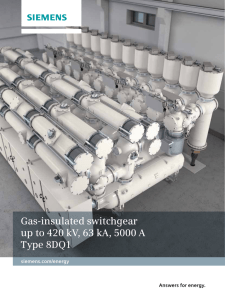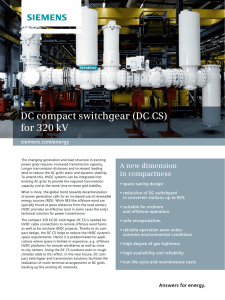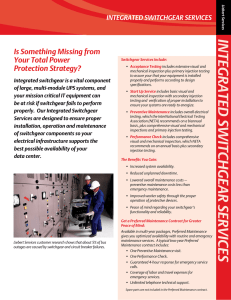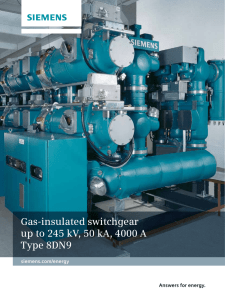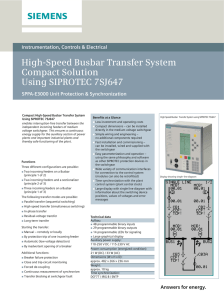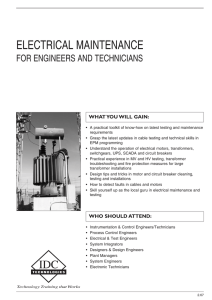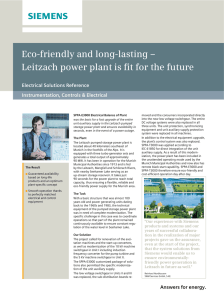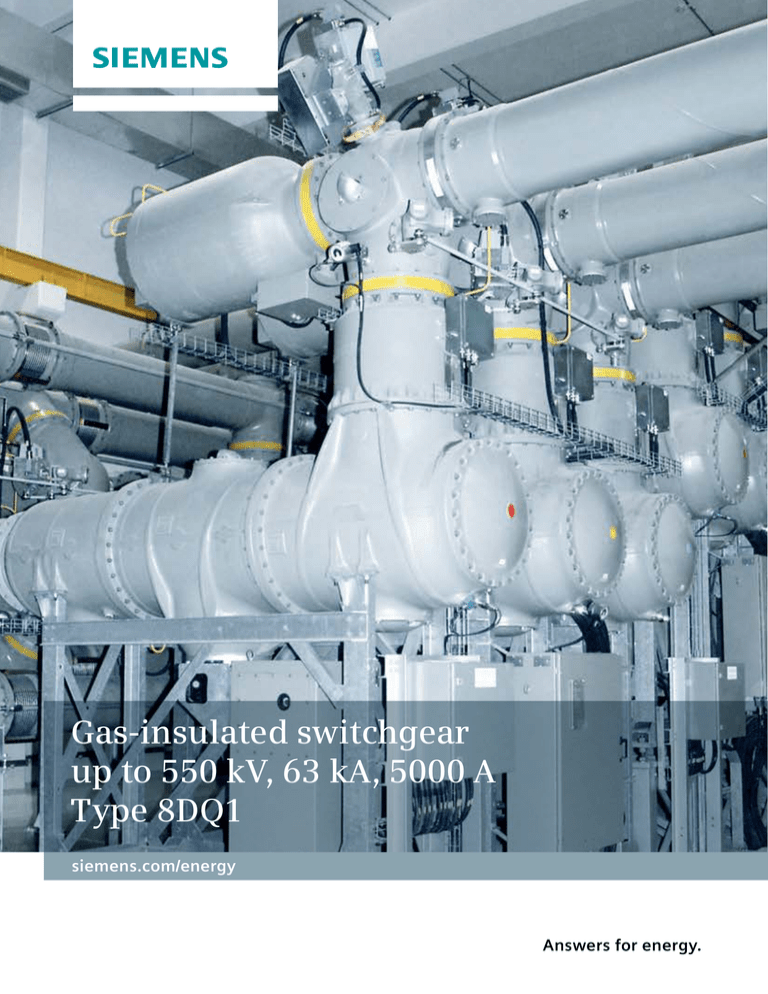
Gas-insulated switchgear
up to 550 kV, 63 kA, 5000 A
Type 8DQ1
siemens.com/energy
Answers for energy.
Leading worldwide
due to innovative technology
Our switchgear ensures extraordinarily high availability at a low operating cost
2
The Siemens gas-insulated switchgear (GIS) is an extremely
successful product concept. Since its introduction back
in 1968, Siemens has installed more than 28,000 indoor
and outdoor switchgear bays worldwide, and well over
300,000 bay-years of operation have been recorded.
Since 1974 we have supplied gas-insulated substations
for voltage levels of up to 420 kV. A permanent process
of improvement has led to today’s 8DQ1, suitable for
a voltage range of up to 550 kV.
Intense research and continuous further development
of the first system types have led to today’s generation
of gas-insulated, metal-encapsulated switchgear –
a world leader in terms of
■■
Economic efficiency
■■
High reliability
■■
Safe encapsulation
■■
High degree of gastightness
■■
Long service life
■■
Low maintenance costs
■■
Easy access and ergonomic design
■■
High availability
■■
Reliable operation even under extreme
environmental conditions
Our current 8DQ1 switchgear, which is designed for rated
voltages of up to 550 kV, meets all requirements for modern, next-generation switchgear in terms of performance
and reliability.
3
Flexibility thanks to modular design
A fundamental feature of our gas-insulated switchgear is
the high degree of flexibility provided by a modular system. The components are arranged in pressure-resistant
gastight enclosures according to their functions. All customary bus schemes can be implemented with only a
small number of active and passive modules.
The switchgear type 8DQ1 up to 550 kV is of single-phase,
metal-enclosed design which minimizes dielectric and
­dynamic loading. The encapsulation material is corrosionresistant aluminum. The O-ring seals – a proven construction principle since 1968 – guarantee gastightness.
4
Coupling contacts capable of absorbing temperature­
related changes in length link the conductors. The insulating and arc-quenching medium is sulfur hexafluoride
(SF6). The extremely tight casing prevents environmental
pollution. Any moisture or decomposition products are
­absorbed by static filters in the gas compartments, which
are attached to the inside of the covers of the access
openings. Rupture diaphragms prevent excessive pressure
in the enclosure. Diverter nozzles on the rupture diaphragms ensure that the gas is expelled in a defined
­direction in the event of bursting, which prevents danger
to the operating personnel.
6
4
M
M
5
M
8
M
9
7
1
12
M
10
13
11
14
With only a few modules, all typical switching configurations can be implemented
14
12
9
10 11
13
1
Typical double busbar feeder
8
7
6
1. Circuit-breaker interrupter unit
2 .Stored-energy spring mechanism
3. Circuit-breaker control unit
4. Busbar I
5. Busbar disconnector I
6. Busbar II
7. Busbar disconnector II
8. Work-in-progress earthing switch
9. Work-in-progress earthing switch
10.Outgoing-feeder disconnector
11.Make-proof earthing switch
(high-speed)
12.Current transformer
13.Voltage transformer
3
2
5
4
14.Cable sealing end
Gas-tight bushing
Gas-permeable bushing
5
Circuit-breaker module
The central element of a switchgear bay within the gas­
insulated switchgear is the single-phase encapsulated
­circuit breaker. The circuit breaker is designed for singlepole automatic reclosure. It consists of two main
­components:
■■
Interrupter unit
■■
Stored-energy spring mechanism
The design of the interrupter unit and the spring mechanism is based on time-tested identical constructions
widely used in air-insulated as well as gas-insulated
switching technology for many years. This design,
­decades of experience, and high quality guarantee
the surpassing reliability of our switchgear.­
Circuit-breaker module
1
2
8
9
10
3
11
4
12
5
13
14
Stored-energy spring mechanism
The stored-energy spring mechanism provides the force
required to operate the circuit breaker. It has a compact,
corrosion-free aluminum housing. Both the opening and
the closing spring are visibly arranged within the drive
unit. The complete drive unit is strictly separated from the
SF6 compartment. Roller bearings and the maintenancefree spring mechanism ensure decades of reliable operation. Proven technology, such as vibration-isolated latches
and load-free isolation of the charging mechanism,
­improve the reliability of the mechanism.
The advantages of the stored-energy spring mechanism:
■■
Identical construction principle for rated voltages from
72.5 to 550 kV
■■
Low operating energy
■■
Simple principle of operation
■■
Switching state controllable at all times
■■
Low maintenance, economical with a long
service life
15
6
16
7
17
1. Closing release
9. Charging mechanism
2. Cam plate
10.Charging shaft
3. Coupling linkage
11.Roller lever
4. Operating rod
12.Closing damper
5.Closing spring
connecting rod
13.Operating shaft
6.Opening spring
connecting rod
7. Closing spring
8.Hand-wound
mechanism
6
14.Opening damper
15.Opening release
16.Mechanism housing
17.Opening spring
Interrupter unit
The interrupter unit used in the circuit breaker for
­arc-quenching operates according to the dynamic
­self-compression principle. This principle requires only
­little operating energy, which keeps the mechanical
­stresses on the circuit breaker and its housing as well
as the foundation loads to a minimum.
Current path
In the closed position, the operating current flows
through the contact finger (2) and the contact cylinder
(10). The arcing contacts (1, 7) are plugged in in parallel
to the main contacts.
Interruption of operating currents
During the breaking operation, the contact finger (2)
with the contact cylinder (10) opens and the current
­commutates to the arcing contacts (1, 7), which are
still closed. This avoids erosion of the main contacts.
As the breaking operation continues, an arc forms
­between the contacts (1) and (7). At the same time,
the contact cylinder (10) compresses the SF6 gas located
in the compression volume (4). The compressed arcquenching gas flows through the heating volume (11)
into the contact gap and extinguishes the arc.
Arc-quenching principle
1. Moving arcing contact
7. Moving arcing rod
2. Main contact
8. Insulating nozzle
3. Check valve
9. Auxiliary nozzle
4. Compression volume
10.Contact cylinder
5. Check valve
11.Heating volume
6. Steering gear
6
7
1
8
2
9
10
3
11
4
Interruption of fault currents
In the case of large short-circuit currents, the gas between
the arcing contacts (1) and (7) is heated by the arc energy.
Thus, the pressure in the heating volume (11) increases.
When the current passes through zero, the gas flows back
from the heating volume (11) through the nozzle (9) and
quenches the arc. The valve (3) of the contact cylinder (10)
prevents the high-pressure gas from entering the compression volume (4). Thus, the operating mechanism does not
have to supply the arc-quenching energy.
5
Breaker in
»On« position
Breaking:
main contact opened
Breaking:
arcing contact opened
Breaker in
»Off« position
7
Disconnecting switches
In the open position, disconnecting switches assure
a dielectrically safe gap between system parts at different
potentials, for example the busbar disconnector isolates
the feeders from the busbar. Cast-resin bushings keep the
contact system in place, and the pressurized gas serves as
the high-voltage insulating medium between live parts
and the metal housing.
The conductor terminals vary for different types of adjacent
modules. Up to two earthing switches can be installed
­simultaneously. The disconnecting switches can be built
as separate gas compartments with their own monitoring
or be combined with surrounding modules.
Disconnecting switch
Earthing switches
Earthing switches (work-in-progress earthing switches or
busbar earthing switches, for example) are used for properly connecting de-energized live parts of the high-voltage
system to the grounding system. On the outgoing side of
the feeders, a make-proof version (high-speed) is frequently
used to dissipate inductive and capacitive currents from
parallel cables or overhead lines or to reduce the risk to
the GIS system in case of faulty connections. In the insulated design they are also used for measuring purposes
and for testing protection relays.
Pin-type earthing switch
Common features of disconnecting
and earthing switches
■■
The three poles of a bay are coupled mechanically
■■
All three poles are commonly operated by one
motor drive
■■
Alarm switches and ON/OFF indicators are
friction-locked and directly connected to the drive
shaft
■■
Identical motor drives are used for disconnecting
and earthing switches
■■
Manual emergency operation is integrated
■■
Enclosures can be fitted with inspection windows
for visual monitoring of the switching position on
request
8
In the switchgear type 8DQ1 up to 550 kV, the earthing
switches are of a pin-type design. Depending on the switchgear design, they are either incorporated in a common
housing with the disconnection switches or installed in
a separate housing. With the pin-type earthing switch,
the earthing pin at earth potential is pushed into the matching contact. Make-proof earthing switches are equipped
with a stored-energy spring mechanism. The spring, which
stores the required switching energy, can be recharged
­either with a motor or manually in an emergency.
Instrument transformers
Both current and voltage transformers are used for
­measuring and protection purposes.
Current transformer
The current transformers are of the single-phase inductive
type with one or more cores and preferably located on the
outgoing side of the circuit breaker. They can, however,
be located at any point within the bay or substation.
The high-voltage conductor forms the primary winding.
The cores with the secondary windings are located on a
grounded electrode and are designed to comply with the
requirements in terms of accuracy, class, and power rating.
Different ratios can be achieved via taps in the secondary
winding accessible in a terminal box. The pressurized SF6
gas between the high-voltage conductor and electrode
serves as the primary insulation. The cores are completely
metal-enclosed which makes for very high reliability in
terms of electromagnetic compatibility (EMC).
Current transformer
Voltage transformer/RC-voltage divider
Each single-phase inductive voltage transformer is encapsulated in its own housing and thus forms a separate gastight
module. Each voltage transformer consists of the following
main components:
■■
The primary winding
■■
One or more secondary windings (forming one coil)
■■
An iron core
The pressurized gas inside the enclosure in combination
with the film insulation provides insulation against high
voltage. The high-voltage connection to the switchgear is
established via the primary conductor, which is supported
by a gastight bushing. The secondary connections are
routed via a gastight bushing plate to the terminal box.
Resistive-capacitive voltage dividers (RCVD) consist of oilimpregnated capacitive elements with parallel mounted
resistors in hermetically sealed glass fiber reinforced plastic tubes (GRP). The RCVD has a common gas compartment with the neighboring gas compartment. It is also
available in another version with a separate gas compartment. The secondary connection can either be designed
as single or as double unit (redundant version). The RCVD
has a smaller size and weight in comparison to inductive
voltage transformers. It is a ferroresonance-free technol­
ogy with no saturable cores. The RCVD maps high voltage
in linear form over a wide frequency range from DC up
to 20 kHz and has an excellent transient characteristic.
The power output is low but sufficient for the demands
of modern protection and energy counting systems
(e.g. ­SIPROTEC 5).
Conventional voltage transformer
RC voltage divider
Surge arrester
If desired, encapsulated surge arresters can be connected
directly. Their purpose is to limit any overvoltages.
Their active parts consist of metal-oxide resistors with
a strongly non-linear current/voltage characteristic. The
arrester is generally flange-jointed to the switchgear via
a gastight bushing that is included with the delivery.
An inspection hole in the arrester housing allows opening
the internal conductor when inspecting the switchgear.
The connections for gas monitoring, arrester testing, and
a surge counter are at the bottom.
Surge arrester
9
Termination modules
The termination modules connect the bays of the gas­
insulated switchgear to the following items of equipment:
■■
Transformer or reactor
■■
Cables
■■
Overhead lines
They form the transition from the SF6 gas insulation
to other insulating media.
Transformer tubetermination
Transformer termination
The transformer termination module enables a direct
SF6/oil tube connection from the GIS to an oil-insulated
transformer or reactor. For this purpose, the transformer
bushing must be oil-tight, gastight, and pressure-resistant.
Temperature-related movements of the switchgear and
the transformer as well as the settling of foundations
are absorbed by expansion joints in the tube connection.
(Acc. to IEC 61639/IEC 62271-211)
Cable termination
This module acts as a link between the metal-enclosed
gas-insulated switchgear and the high-voltage cable.
All types of high-voltage cables complying with
IEC 62271-209 can be connected. The inspection hole
also provides the connecting flange for the high-voltage
cable testing set. During high-voltage cable testing, the
primary conductor between the cable sealing end and
the switchgear can be removed.
Cable termination
SF6 /air termination
The SF6/air termination module enables the connecting
of the gas-insulated switchgear to air-insulated components or overhead lines by means of a bushing, which
is available either as a porcelain or a composite insulator.
This termination is a combination of an angle-type module
and an SF6 bushing. The length, shed form, and creepage
distance of the outdoor/SF6 bushing can be adapted to
various requirements with regard to insulation coordination, minimum clearance, or degree of pollution.
SF6 /air termination
10
Extension and angle-type modules
These modules are used for connections within a bay and
for conduit lead-outs. Their shape and number depends
on the circuit and the layout of the bay.
Extension module
Angular module
Busbar module
The switchgear type 8DQ1 up to 550 kV has a singlephase encapsulated passive busbar, i.e. without integrated
switching devices. Busbar disconnecting switches, sectionalizers, and earthing switches are housed in separate
gas compartments. Depending on the configuration,
­extensions and maintenance work are easily effected with
the switchgear in operation. The busbar modules of adjacent bays are connected with expansion joints which
­absorb constructional tolerances and temperature-related
movements in both longitudinal and transverse directions
to the busbar. Axially guided sliding contacts between
the conductors compensate temperature-related changes
in conductor length. A sectionalizer is easily fitted to
­increase the availability of the system.
Busbar module
11
Control and monitoring –
a reliable and flexible control
and protection system
Control cubicle with circuit-breaker operating mechanism
Proven switchgear control
Robust electrical components are used to control and
monitor the circuit breaker as well as other switchgear
components. All elements necessary for the control and
monitoring of the circuit breaker and the disconnecting
and earthing switches are incorporated locally in the
­respective high-voltage devices. All device controls are
tested at the factory. This cuts commissioning time to
a minimum and avoids failures on-site.
Gas monitoring
Gastight insulating partitions subdivide each switchgear
bay into functionally separate gas compartments (e.g.,
­circuit breakers with current transformers, disconnecting
switches, voltage transformers, surge arresters, and termination modules). Density monitors with red/green indication constantly monitor the gas compartments and provide alarm and blocking signals via contacts.
Reliable and flexible control and protection system
The control unit is housed in the local control cubicle,
which provides for easy access.
As an option, the feeder protection can also be included
in the same cubicle. The local control cubicle is usually
­located opposite the switchgear. Shielded cables and
­coded plugs are used for the cabling between the local
12
control cubicle and the high-voltage switching devices,
which minimizes both installation cost and the risk of
­cabling errors. On request, we can supply our high-voltage
switchgear with any of the commonly available digital
control and protection systems.
Standard interfaces in the local control allow
the connection of
■■
Conventional control systems with protective
­interlocking and control panels
■■
Digital control systems with user-friendly bay
­controllers and station automation with PC
­workstations (HMI)
■■
Intelligent, fully networked digital control and
­protection systems with additional monitoring
and remote diagnostic functions
Thanks to the extensive range of Siemens control and
­protection systems, we can offer you customized concepts
from a single source.
Transport, installation,
commissioning, maintenance
Transport
To facilitate easy transport and on-site installation, our
switchgear assemblies are split into optimized shipping
units with emphasis on ease of handling. Standard switchgear bays are usually shipped as one transport. All shipping units are mechanically and dielectrically tested
­before dispatch. In the case of modules which contain
switching devices, all operating-mechanism attachments
are preset at the factory prior to shipment. All flanges,
where the modules are to be joined to other equipment,
are protected against corrosion and sealed with transport
covers.
All goods are packed according to means, duration, and
route of transport as well as in line with conditions and
duration of storage. Shipments within Europe are normally
done by road. Switchgears supplied to overseas countries
are sealed in suitable shipping units with seaworthy packing, taking into account any temporary storage that may
be necessary.
On-site installation
The fact that the switchgear is split into a few, easy-tohandle shipping units reduces the time and effort required
for installation on site. Detailed installation instructions
and the use of relatively few special tools allow easy and
rapid installation of the switchgear. It can even be effected
by your own personnel under the supervision of an experienced supervisor from Siemens. Our training ­facilities are
at your disposal if required.
Commissioning
After completion of the assembly work on-site, all switching
devices and electrical circuits for controlling and monitoring
are tested to ensure proper electrical and mechanical function of the whole system. All flanges are double-checked
for tightness. Commissioning work on the primary section
ends with the high-voltage test on-site to verify that all
­installation work has been carried out correctly. All tests
are performed in accordance with IEC standards and the
­results are documented in the final test reports.
Maintenance
Our gas-insulated switchgear installations are designed
and manufactured to provide an optimum balance in
­design, materials used, and maintenance measures.
Thanks to the hermetically sealed enclosure, a minimum
of maintenance is needed and the GIS system can even
be regarded as maintenance-free under normal operating
conditions. Subject to environmental conditions, visual
­inspections are recommended. A visual inspection is carried out bay by bay without any need for outages or the
opening of gas compartments. The first major inspection
is not due until after 25 years.
13
Quality assurance
A consistent quality management system supported by
our employees makes sure that we produce high-quality
gasinsulated switchgear. The system was certified in 1983
in accordance with CSA Z299 and again in 1989 according
to DIN EN ISO 9001. The quality management system is
subject to continuous improvement. Certification according
to DIN EN ISO 9001:2000 was passed with flying colors
in 2003. As early as 1994, the environmental protection
system according to DIN EN ISO 14001 was implemented
as an addition to the existing quality management system
and successfully certified. One of the fundamental milestones in developing testing competence was the certification of the test labs according to ISO/IEC 17025 (previously
EN 45001) in 1992 and the accreditation as an independent
PEHLA test lab.
The quality management and environmental protection
systems cover every single process in our products’ life
­cycles, from marketing to after-sales service.
Regular management reviews and internal audits of all
­processes based on the consistent documentation of all
processes relevant to quality and environmental protection ensure that the system is efficient and up-to-date
at all times and that appropriate measures are taken to
continuously improve it. Consequently, the quality of our
switchgear meets even the highest requirements.
In addition to consistent quality management and environmental protection, the special »clean« areas set up in
the production workshops are an important contribution
towards the high quality of our gas-insulated switchgear.
Comprehensive manufacturing inspections and routine
testing of individual components, sub-assemblies, and
complete modules all play an important part in ensuring
reliable operation of the overall product. Mechanical routine and high-voltage tests of the complete bay or complete shipping units verify that the manufactured quality
complies with the standards. Suitable packing provides
for the switchgear’s safe arrival at its destination.
14
Switchgear bay examples
The modular system not only allows all customary circuit
arrangements but also individual solutions for specific
building dimensions, system extensions, and much more.
Double busbar arrangement
M
M
6000
M
5000
M
M
Bus coupling arrangement
4900
6000
15
Double busbar arrangement with transfer bus
6000
M
M
M
6300
M
M
M
Double busbar arrangement with bypass
6000
M
M
M
M
M
6300
M
1½ circuit-breaker arrangement
M
M
23700
M
M
M
M
M
6300
M
M
M
M
M
M
M
M
M
16
Technical data
Switchgear type
Rated voltage
8DQ1
up to
Rated frequency
550 kV
50 / 60 Hz
Rated short-duration power-frequency withstand voltage (1 min)
up to
740 kV
Rated lightning impulse withstand voltage (1.2 / 50 μs)
up to
1,550 kV
Rated switching impulse withstand voltage (250 / 2,500 μs)
up to
1,175 kV
Rated normal current busbar
up to
5,000 A
Rated normal current feeder
up to
5,000 A
Rated short-circuit breaking current (< 2 cycles)
up to
63 kA
Rated peak withstand current
up to
170 kA
Rated short-time withstand current (up to 3 s)
up to
63 kA
Leakage rate per year and gas compartment (type-tested)
< 0.1 %
Driving mechanism of circuit breaker
stored-energy spring
Rated operating sequence
O-0.3 s-CO-3 min-CO
CO-15 s-CO
Bay width
Bay height, depth (depending on bay arrangement)
Bay weight (depending on bay arrangement)
Ambient temperature range
Installation
3,600 mm
4,800 mm x 10,000 mm
21 t
-25 ºC up to +55 ºC
indoor
First major inspection
> 25 years
Expected lifetime
> 50 years
Standards
IEC / IEEE / GOST
Other values on request
17
Published by and copyright © 2013:
Siemens AG
Energy Sector
Freyeslebenstrasse 1
91058 Erlangen, Germany
For more information, please contact
our Customer Support Center.
Phone: +49 180 524 70 00
Fax:
+49 180 524 24 71
(Charges depending on provider)
E-mail:support.energy@siemens.com
High-voltage products
Order No.: E50001-G630-A240-X-4A00
Printed in Germany
Dispo 30002, c4bs No. 7460
TH 263-130679 473683 WS 12132.
Printed on elementary chlorine-free
bleached paper.
All rights reserved.
Trademarks mentioned in this document
are the property of Siemens AG, its affiliates,
or their respective owners.
Subject to change without prior notice.
The information in this document contains
general descriptions of the technical options
available, which may not apply in all cases.
The required technical options should therefore
be specified in the contract.



